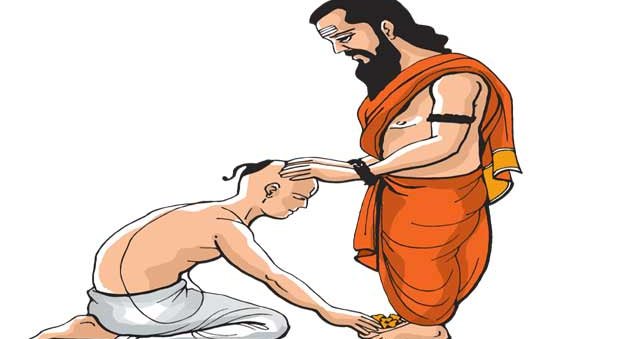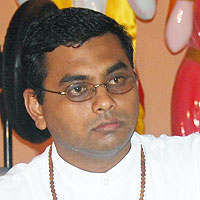Guru Purnima is a day dedicated to the honouring and worship of the Guru. We have maintained that there are three types of Gurus. There is the Diksha Guru or the spiritual preceptor, the Vidya Guru or the teacher and the Kul Guru, the family priest. In some cases, each one is different, but the Guru Gita tells us that if the Guru has the capacity, he can be all three. On this auspicious day, we worship the Diksha Guru, the one who has initiated us into divine life.
Why do we get initiated? It is said that life can be compared to a ship sailing on an ocean of duality or mundane existence. A ship without a captain would soon come to an unfortunate destination; even sink, if there is no guidance. Initiation is a process through which we accept the captain of the ship of life whom we call the Guru. He is supposed to guide us as we go through life in this world of duality. We all need guidance at some point in time and we are instructed by our scriptures. We are told, when we are born, we are in a state of impurity; spiritually, that is a state of ashuddhi. Then we are initiated; it is a spiritual birth. So we are, as we say, twice born. The older ones will tell you that you shouldn’t do puja until you are initiated, meaning the state of impurity exists and if you have to perform puja, there must be a state of purity. The Guru is the guide who is key for success in life.
Let us look at a few verses from the Guru Gita, which will help us to understand both sides – the Guru and the disciple. Who narrated the Guru Gita? What is its authority? Shree Sutaji Maharaj, who was a disciple of that great Guru, Ved Vyaasji, many many years ago, having a conversation with the sages on dharma, philosophy, karma kaand and various aspects of life, related Bhagwat Maha Puraan, Shiv Puraan and Devi Bhaagwat. Many episodes were related to these sages, who were absorbed in divine ecstasy. The topic of this discussion was the Guru, the spiritual preceptor.
So Shree Sutaji Maharaj said, “O sages, on that beautiful mountain, Kailash, Goddess Parvati bowed with great reverence before Bhagavan Shankar, that Shiva, who it is said, leads one to union by devotion.” Shiva symbolises vairaagya, dispassion, without which there can be no bhakti, devotion. Goddess Parvati began by saying, “Om. Salutations to you, O Bholenath, O Lord of Gods, higher than the highest, and teacher of the universe, Jagat Guru. She recognised Shiva to be this and these statements are made to help us understand that whatever Shiva said would be authoritative. She is saying, “O Benevolent One, O Great God, initiate me into the knowledge of the Guru. O Lord, by which path can an embodied soul become one with Brahma, that absolute reality? What is the way to that Supreme?”
Some of the mahaa vaakyas (the great sayings) are: Aham Brahmasmi; Chidanand Rupaham, Shivoham, Shivoham; Tat Twam Asi. How can we attain that Supreme state? What is the pathway to that ultimate reality? By which path can an embodied soul, meaning every one of us, become one with the Supreme? Parvati Ma said, “O Bholenath, O Compassionate One, be compassionate to me. I bow to your feet.” Notice the kind of reverence Parvati Ma had and her approach in asking her questions; this is the attitude students and disciples should have.
Then that Supreme Lord, Bhagavan Shankar, Jagat Guru said, “O Goddess, you are my very Self. Out of love for you, I will speak. Your questions are helpful to the world. Out of love for you, my very Self, I am going to speak to you.” The Vedas have said to us that we are all part of that Shiva. This brings a question to mind: sometimes, out of love, we admonish, we use different strategies to help to put people on the pathway. However, because of ignorance, people tend to understand differently. But Bhagavan Shankar knows we don’t know everything; we are in agyaan (ignorance). Out of love he speaks as the Jagat Guru. Similarly, this is the approach the true Guru will take because he will see everybody as a reflection of himself. If he’s saying, “Guru Bramha, Guru Vishnu, Guru Maheshwar”, then everyone is a reflection of the Guru. Here, Parvati was the perfect disciple. She surrendered and this is the approach. To be enlightened, you have to surrender to the Guru.
Bhagavan Shankar is saying, “This knowledge you are asking about, O Parvati, is very difficult to obtain in the three worlds. I will reveal it to you. Apart from the Guru, there is no other Brahm.” He is saying, there is a journey towards that Brahm. If it is that “Guru Bramha, Guru Vishnu, Guru Maheshwar”, then the Guru has to be Brahm. However, that Brahm is infinite. We can’t identify with it; it doesn’t have a form. It is unconditioned, without attributes, whereas we are conditioned to a world of space, time, causation, name and form. So we can’t identify with that which is beyond attributes. Therefore, we start with the known and we go to the unknown. So, in this context, the Guru is supposed to be the known Brahm. If one has the right understanding of the Guru, then this is the beginning of the journey.
Bhagavan Shankar goes on to say, “O Parvati, this is the truth. The Vedas, the Shastras, the Puraanas, the historical accounts and other writings, the science of mantra, the yantra (mystical diagrams using composite shapes), the smritis (those established, traditional books that speak about the laws), magical incantations and so on, all these bring about the downfall of those whose minds are deluded.” He is not saying that these texts are not good, but if you are in delusion, you won’t understand them correctly. This is a problem in today’s world. Many people download from the Internet. They have access to the books and they could read them. However, to know the text literally is one thing, to know the meaning of the text is quite another. Bhagavan Shankar is saying, this attitude leads to a downfall. For a deluded person who doesn’t have the right understanding, these things could sink us because of a superficial understanding.
Bhagavan Shankar says, “These people are fools who engage in sacrificial rites, vows, penance, jap (repetition of mantras), charity and also pilgrimages without knowing the Guru principle.” In the Ramaayan, Bhagavan Shree Raam says it’s a journey: you associate with holy men; you become informed; you sit and listen to scriptures read to you, but then you need an enlightened Guru, no matter who you are. Even the Guru needs a Guru. The Guru is the way. Bhagavan Shankar is saying to us that without the knowledge of the Guru principle, our jap, our yagya, all these principles and practices will come to nought.
However, knowing the Guru principle does not mean knowing the Guru. Knowing the Guru’s name, etc., that is the Guru’s form. This is what the Guru Gita is about. So many of us celebrate Guru Purnima and we worship the Guru. These things are good as they bring about a certain level of psychological comfort. Spiritually, however, I have to understand and live up to the Guru principle.
“The Guru is not different from the knowing Self.” This is an important statement. But then I have to look at the other side. The Guru has to have the capacity for that realisation. How could he guide us to know the self if he himself doesn’t identify with the self. One may put on the garb of the Guru but is he qualified? What sacrifice has he done? What is the extent of his realisation of that Supreme Purusha? Questions have to be asked. Life is about living and the experience of the Guru, the spirituality of the Guru, is what is going to help you. Bhagavan Shankar is emphasising this. He says that without doubt, this is the truth. Therefore, wise men should make an effort to attain him. Parvati, the illusion of the world, the veiled knowledge, born of ignorance, resides in the body of a person. He, by whose light, true knowledge arises is referred to by the word, ‘Guru’. He helps that true knowledge, that inner light, to wake up inside of you.
From a discourse by Paramacharya of SWAHA, Pundit Hardeo Persad




Sita Ali
Bhagwan’s Blessings to my spiritual preceptor, my Guru! May he live a long and healthy life.